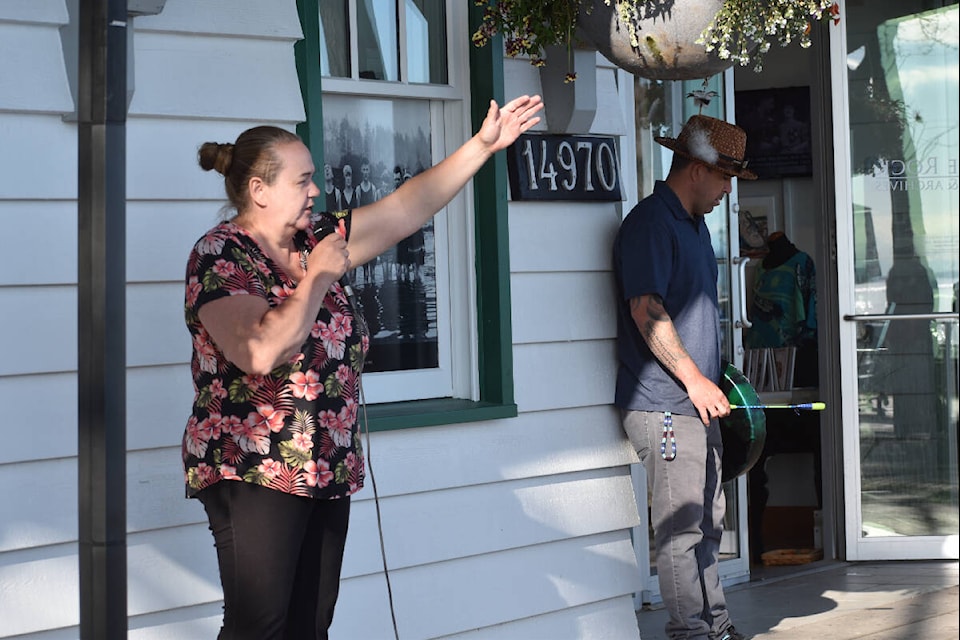A crowd of some 70 people, including invited guests and passersby, gathered outside White Rock Museum and Archives last week (June 22) as the Semiahmoo First Nation, the City of White Rock and the museum formally marked the opening of the exhibit Che’ Semiahmah-Sen, Che’ Shesh Whe Weleq-sen Si’am (I am Semiahmoo, I am Survivor of the Flood).
The show, a scaled-down version of an exhibit developed in partnership with SFN and presented last year by the Museum of Surrey, was launched with traditional songs and dances by Chief Harley Chappell and family members (including his sons and daughter and a nephew).
Also among those attending were SFN elder Mabel Charles, and councillor Joanne Charles; as well as White Rock Mayor Darryl Walker and council members David Chesney, Christopher Trevelyan, Scott Kristjanson and Erika Johanson.
“We’re not here performing – we’re sharing,” Chappell noted, as he introduced a ‘flood song’ relating to a great flood that occurred thousands of years ago but that still is part of the oral history preserved by the Semi ah ma people and other related nations in the area.
Warned of the impending natural disaster, the Coast Salish peoples of the region prepared special boats to help preserve the children and the supplies, Chappell told the crowd.
Many of the peoples who survived the flood found themselves landed on new territories in the region when the flood waters receded, he said, and added the suffix ‘-ish’ to the name of the nation in recognition of that fact.
Chappell said he had asked an elder of the Lummi nation, just south of the border why the Se mi ah ma had not taken the ‘ish’ suffix.
“I was told it was because we ended up right where we’d been, on the bay and some of the nearest islands,” he said.
“P’Qalls (the white rock) is a marker, a reminder of that world a long, long time ago – a very different world,” he said, adding that most cultures around the world have records of ‘mythical times’ as distinct from formal history.
“For us that distinction never happened – these (songs and stories) are our history,” he said.
Chappell also noted the “ripple effect” of awareness created by the opening just the day after marking National Indigenous Day at Chief Bernard Robert Charles Memorial Plaza.
READ ALSO: Semiahmoo First Nation dances, history shared on Indigenous Peoples Day
Museum executive director Karin Bjerke-Lisle, Joanne Charles and Walker also offered welcomes and prefatory remarks to the show, which runs until Oct. 2.
In addition to woven cedar pieces and a traditional cloak, it also includes comparative timelines for SFN history and detailed scale dioramas by archaeologist Don Welsh, illustrating the sophisticated technology of reef fishing practised hundreds of years ago, and a typical summer fishing village.
Walker said he sees the show as part of an ongoing learning about the history of Canada’s Indigenous peoples, including the prejudice and marginalization they have endured, and the multiple tragedies of the Residential School system.
“There are sometimes things that are difficult things to learn, but it’s important for us and the wellbeing of the community,” he said.
“If we learn from each other, we will be stronger and our communities will be stronger,” he said.
alex.browne@peacearchnews.com
Like us on Facebook and follow us on Twitter
